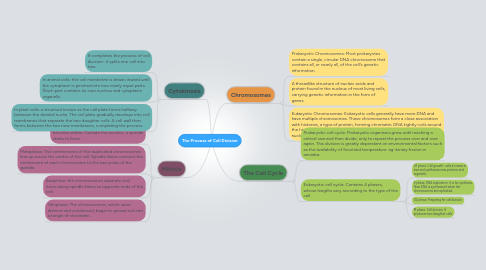The Process of Cell Division
Door ferin ahmed


1. Mitosis
1.1. Prophase: Genetic material inside the nucleus condenses and the duplicated chromosomes become visible. Outside the nucleus, a spindle starts to form.
1.2. Metaphase: The centromeres of the duplicated chromosomes line up across the centre of the cell. Spindle fibres connect the centromere of each chromosome to the two poles of the spindle.
1.3. Anaphase: the chromosomes separate and move along spindle fibers to opposite ends of the cell.
1.4. Telophase: The chromosomes, which were distinct and condensed, begin to spread out into a tangle of chromatin.
2. Cytokinesis
2.1. It completes the process of cell division- it splits one cell into two.
2.2. In animal cells: the cell membrane is drawn inward until the cytoplasm is pinched into two nearly equal parts. (Each part contains its own nucleus and cytoplasm organells.
2.3. In plant cells: a structure known as the cell plate forms halfway between the divided nuclei. The cell plate gradually develops into cell membranes that separate the two daughter cells. A cell wall then forms between the two new membranes, completing the process.
3. Chromosomes
3.1. Prokaryotic Chromosomes: Most prokaryotes contain a single, circular DNA chromosome that contains all, or nearly all, of the cell's genetic information.
3.2. A threadlike structure of nucleic acids and protein found in the nucleus of most living cells, carrying genetic information in the form of genes
3.3. Eukaryotic Chromosomes: Eukaryotic cells generally have more DNA and have multiple chromosomes. These chromosomes form a close association with histones, a type of protein, forming chromatin. DNA tightly coils around the histones, and together, they form beadlike structures called nucleosomes.
4. The Cell Cycle
4.1. Prokaryotic cell cycle: Prokaryotic organisms grow until reaching a critical size and then divide, only to repeat the process over and over again. This division is greatly dependent on environmental factors such as the availability of food and temperature. eg: binary fission in amoeba.
4.2. Eukaryotic cell cycle: Contains 4 phases, whose lengths vary according to the type of the cell.
4.2.1. G1 phase: Cell growth- cells increase in size and synthesize new proteins and organells.
4.2.2. S phase: DNA replication- S is for synthesis. New DNA is synthesized when the chromosomes are replicated.
4.2.3. G2 phase: Preparing for cell division.
4.2.4. M phase: Cell division. It produces two daughter cells.
